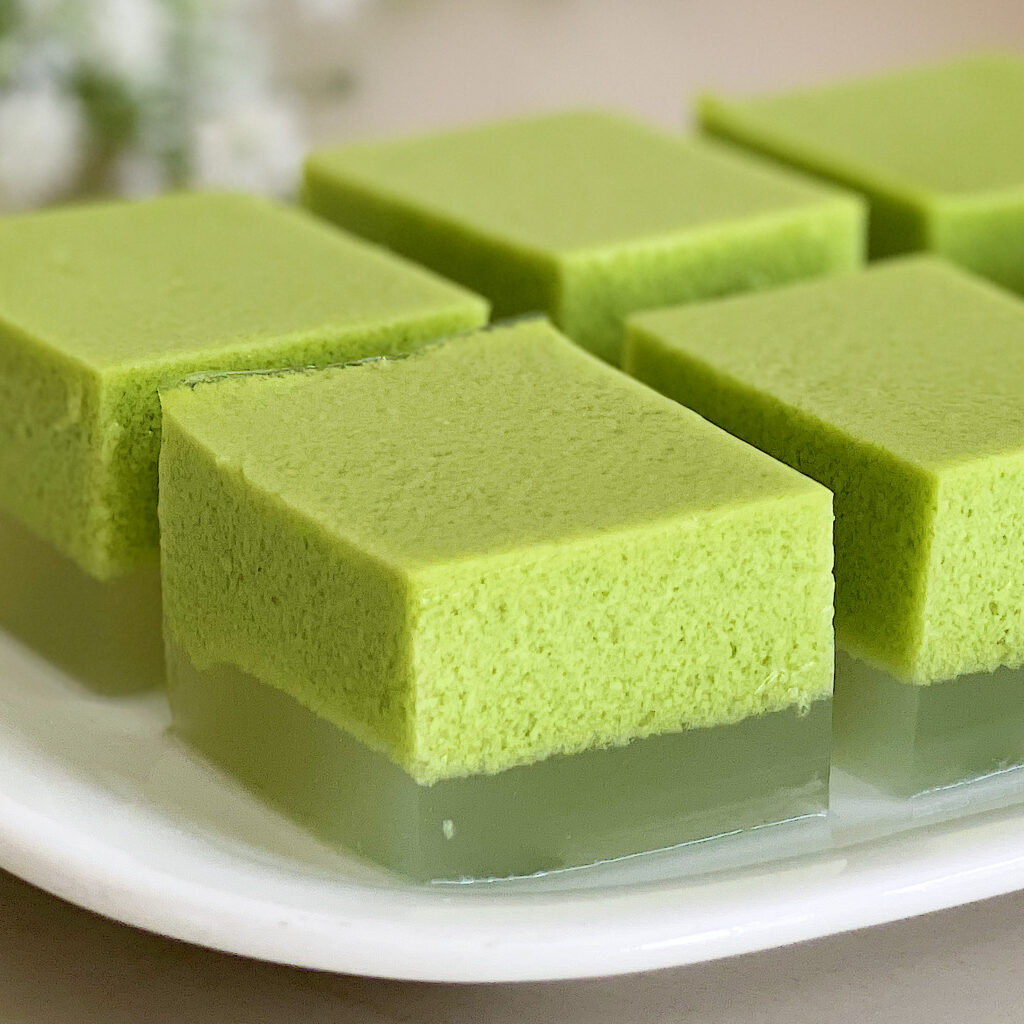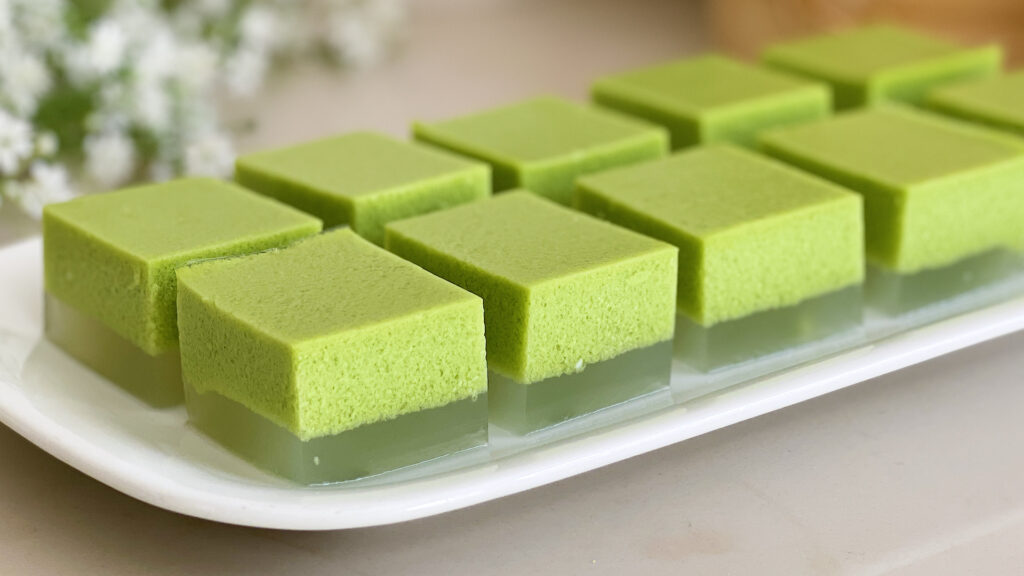This Pandan Coconut Milk Agar-agar Jelly recipe is from my Godmother. It is so delicious you have to try it!
Pandan Coconut Milk Custard Agar-agar Jelly Cake has a layer of coconut milk custard at the top and Agar-agar jelly at the bottom.
The coconut milk custard is infused with pandan to make it more fragrant. The beauty of this Pandan Agar-agar jelly dessert is there is no need to do two separate layers to achieve this layering effect. After cooking, the Agar-agar jelly will naturally separates into 2 layers.

Pandan is a tropical plant widely available in South East Asia. Pandan leaves or pandan juice is frequently used in cooking dessert or savoury dishes in South East Asia. Pandan flavour is the South East Asian closest equivalent to vanilla extract. I get my pandan leaves from my garden :P.
Why the Pandan Layer and transparent Layer don’t separate well?
The main reason could be the density of the coconut. The reason the coconut layer floats to the top is because after boiling, the coconut becomes less dense compared to the agar-agar liquid. Some coconut milk is less rich. In this recipe I used Ayam Brand coconut milk, you may want to try this.
FREQUENTLY ASKED QUESTIONS
What is Agar-agar?
Agar-agar is extracted from seaweed and is plant-based. It works like gelatin and is often used to make jelly, especially in Asia. Being plant based, it has become very popular amongst vegetarians or vegans as a substitute for gelatin. It is odorless and does not contribute much taste to the jelly, perhaps just a slight hint of fragrance.
Agar-agar comes in powder form or strips. You can substitute agar-agar powder with agar-agar strips if preferred.
My jelly texture is too soft/firm, can I change the texture?
Yes, you can. The texture of the jelly is based on the ratio of water/liquid to agar-agar powder. So if you prefer softer texture, reduce the jelly powder or vice versa.
Why does my jelly not set?
Not enough agar-agar powder used. Different brand of jelly powder have different liquid to agar-agar powder ratio. Generally the ratio is 1g powder = 100ml liquid but may differ from brand to brand.
Agar-agar starts to activate its gelling properties when the liquid is heated above 80-90°C. So it is necessary to make sure the liquid is cooked until it is boiling. Then leave to cool to room temperature. It will start to solidify below 40°C.
What is the texture of agar-agar?
Agar-agar texture is more stiff compared to gelatin. Hence it is not so jiggly and springy.
Troubleshooting – My jelly did not set, what can I do about it?
Step 1 – If it is your first time trying the recipe there is a test you can do. Before pouring into the mold, just scoop up a small portion of the liquid into a small saucer. Place it into the fridge to set. It should take about less than 5 minutes. Check the texture of the jelly. If you are happy with it, the proceed to pour into the mold. If it did not set, add more jelly powder (before adding the powder, dilute it in some room temperature water first), pour into the existing jelly liquid and heat up the liquid again. Redo the test and once you are happy with the texture, pour into the mould
Vice versa, if you find the texture of the jelly is too stiff/hard, add more water into the existing jelly liquid and heat up the liquid again. Redo the test and once you are happy with the texture, pour into the mould
Step 2 – If you have already poured into the mold and eventually find out that it did not set. Don’t throw it away! You can always fix it. Just simply place the liquid into a pot, add jelly powder, mix well and reheat again. Then repeat the above step 1 to test the jelly.

Cooking Tips:
- After adding in the coconut milk and Pandan juice into the beaten egg, use a fork or chopstick to gently mix the mixture. Do NOT use a whisk to beat/mix as it will create a lot of bubbles and the Pandan coconut layer will not be smooth after the Agar-agar jelly sets.
- When pouring the Agar-agar jelly mixture into the mold, use a ladle and pour in scoop by scoop. Do NOT pour directly from the pot. Doing that will create a lot of bubbles and the Pandan coconut milk layer will not separate evenly and the will not be smooth and creamy.
- After adding the Pandan and coconut milk into the pot, make sure to bring it to boiling point
- When pouring into a mold, use a ladle/scoop so that the 2 layers are evenly distributed.
- I used 150 grams of sugar because I don’t like it too sweet. It may not be sweet enough, recommend to use 200-250 grams sugar. It does taste better when its sweeter.
- The agar-agar packet I use is “Swallow Globe Brand” ratio is 10 grams for 1000 ml water. In this recipes I used 1200 ml liquid for softer texture. If you like the jelly to have more firm texture, you can reduce the water level by 100ml.
- Recommend not to use mold bigger than 7 inch by 7 inch wide. Based on feedback, if the mold is bigger, the Pandan layer did not separate well. Also not to mini size mold.

Pandan Coconut Milk Custard Agar-agar Jelly Cake | 香兰椰奶燕菜果冻糕
Ingredients
- Pandan juice concentrate (20 pandan leaves + 100 ml water, room temperature)
- 200 ml coconut milk (santan)
- 1 egg (room temperature)
- 1 packet (10 grams) agar agar jelly
- 900 ml water
- 150 grams sugar (you may want to increase to 200-250 grams sugar if you like it sweet)
Kitchen Tools used
- 7 inch by 7 inch mold
Instructions
- Cut the pandan leaves into smaller pieces, place in the blender, add water and blend well
- Strain the juice, you should get 95ml -100ml of pandan juice
- Sieve again with a fine strainer
- Whisk egg, add in the pandan juice and coconut milk
- Use a fork or chopstick to mix well, do NOT use a whisk
- In a large pot, add 10 grams agar-agar powder, sugar and water. Mix well.
- On low heat, bring the mixture to a boil, mix occasionally so that lumps do not form
- Reduce to lowest heat, scoop up half the liquid into a bowl. Use a ladle instead of pouring from pot as we do not want to liquid to be too hot.
- Pour into the Pandan Coconut mixture. Gently mix well with a chopstick or fork.
- Pour back into the remaining agar-agar mixture in the pot.
- Increase to medium heat, bring to boil. Mix occasionally
- Once it starts to boil, off the stove immediately
- Use a ladle and pour into a mould, let it set, do not move the mould
- Once set, place in the fridge to chill. Serve cold.
Notes
- After adding in the coconut milk and Pandan juice into the beaten egg, use a fork or chopstick to gently mix the mixture. Do NOT use a whisk to beat/mix as it will create a lot of bubbles and the Pandan coconut layer will not be smooth after the Agar-agar jelly sets.
- When pouring the Agar-agar jelly mixture into the mold, use a ladle and pour in scoop by scoop. Do NOT pour directly from the pot. Doing that will create a lot of bubbles and the Pandan coconut milk layer will not separate evenly and the will not be smooth and creamy.
- After adding the Pandan and coconut milk into the pot, make sure to bring it to boiling point
- When pouring into a mold, use a ladle/scoop so that the 2 layers are evenly distributed.
- I used 150 grams of sugar because I don't like it too sweet. It may not be sweet enough, recommend to use 200-250 grams sugar. It does taste better when its sweeter.
- The agar-agar packet I use is "Swallow Globe Brand" ratio is 10 grams for 1000 ml water. In this recipes I used 1200 ml liquid for softer texture. If you like the jelly to have more firm texture, you can reduce the water level by 100ml.
- Recommend not to use mold bigger than 7 inch by 7 inch wide. Based on feedback, if the mold is bigger, the Pandan layer did not separate well. Also not to mini size mold.
